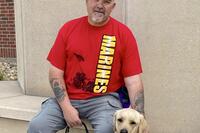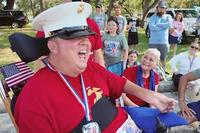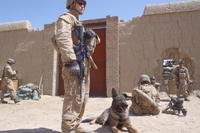On March 4, 1966, the U.S. Marine Corps and the Army of the Republic of Vietnam (ARVN) launched Operation Utah, an effort to counter the growing number of North Vietnamese troops in South Vietnam's Quảng Ngãi province. After American airstrikes cleared a landing zone in the area, the ARVN 1st Airborne Battalion would secure it. The U.S. 2nd Battalion, 7th Marines would then enter the area and the two forces would push outward.
It was a simple operation on paper, but the aircraft involved all met heavier anti-aircraft resistance than expected. The ground forces soon found that all resistance in the area was heavier than expected, too. Twenty-year-old Pfc. Danny Hernandez was one of the Marines deployed in Quảng Ngãi during Operation Utah. His actions there would earn him a Silver Star -- 43 years later.
After their insertion, the Marines had no idea they might have been outnumbered two-to-one by two battalions of the 21st NVA Regiment. As the day wore on, the Marines pressed forward, but the communist forces kept the lines so close, the Americans could not use artillery and air power to gain an advantage. As the sun went down on March 4, the Americans and ARVN were split in two.
The Marines realized the People's Army of Vietnam (PAVN) would not be pushed out of the province without a fight, so they called in the 3rd Battalion, 1st Marines to reinforce the American position. Hernandez deployed just before dark with the 3/1 Marines, he wrote in his book, "Silver Star: An American Story." The objective was Hill 50, with its camouflaged and reinforced bunker complex.
His company came under an intense enemy attack on their first night in Quảng Ngãi, including mortar and artillery fire, but by morning, the Marines were re-formed and ready to attack. As they moved across a rice paddy toward the hill in the early morning hours, they suddenly found themselves in the middle of a "horseshoe kill zone," and that the North Vietnamese headquarters was not just in Hill 50, but extended in tunnels surrounding their current position.

The surprise attack broke the company's formation, as the PAVN hit the Marines with everything it had. Some Marines were fighting in close quarters, while others were reorganizing and some were taking cover from enemy fire. By noon on April 5, Hernandez and his battle buddy were both out of ammo and separated from the company.
As he looked around the growing battlefield, he noticed another Marine machine gun squaring off with a North Vietnamese machine gun. But in the middle of the enemy's kill zone, he saw a Marine lying on the ground, in the middle of an open area. The PAVN was just waiting for the Marines to try to rescue their fallen man.
Hernandez realized he had a much better chance of pulling the Marine to safety, because he had better cover and concealment along the way. With the other company pinned down, he made his way to the edge of the open area. His fallen comrade was Pfc. Joel Rodriguez, and blood was starting to pool all around the wounded man.
Hernandez signaled to the Marine machine gun crew that he was ready to make a dash for their fallen friend. Without a second thought, he made a break for Rodriguez. The other Marines laid down heavy suppressive fire as he moved across the open ground.
When Hernandez reached him, Rodriguez was bleeding and gasping for air. Before he could render aid, the PAVN machine gun began firing on him in the open field. Hernandez shielded the wounded man with his body, taking a hit to the back that felt like a sledgehammer blow.
Bullets whizzed around them as they lay there, until they suddenly stopped. Hernandez realized this was his window. He got up, pulled Rodriguez by his arms and flak jacket, and dragged his comrade to the safety of the other Marines. Rodriguez was taken by stretcher to the medevac zone, with Hernandez close behind.
As they reached the medevac area, Hernandez saw many members of his company dead and wounded. Filled with rage, he refused to be evacuated. He picked up a rifle and went back into the fight. When he got there, he jumped into a foxhole and found his M60 machine gun, his "A" gunner and the gun's ammunition replenished. Hernandez then retook control of the machine gun.
By then. enemy soldiers were emerging from tunnels and spider holes as Marines prepared to assault those tunnels. Hernandez moved to join them, but as he did, he noticed the enemy was making a move to attack the medevac zone. He called for help, but his fellow Marines were too far away.

Hernandez jumped across a nearby treeline to set his gun between the enemy and the wounded. With bullets flying at him from all directions, he exchanged fire with the enemy as one charged him. When the charging soldier fell, Hernandez then poured fire into a cave from which other PAVN soldiers were emerging. He charged the tunnel, and after about 10 feet in, the ceiling collapsed.
The enemy escaped, but Hernandez was able to walk out of the fallen cave. A few yards away from the opening, he collapsed in exhaustion, but the battle was far from over. Operation Utah would last another two days and would be remembered as one of the bloodiest battles fought by the Marines in Vietnam. Almost 400 Marines were killed or wounded while North Vietnamese suffered 1,100 killed or captured in just three days.
His commander, Marine Corps Lt. Jim Lupori, recommended Hernandez for the Silver Star. He was soon transferred to another unit and assumed Hernandez had received the honor. It wasn't until the two men were reunited over lunch in 2005 that Lipori learned Hernandez never received the Silver Star.
Lipori spent the next three years gathering evidence across the United States, making calls and requesting help from public officials to get Hernandez the medal. It was finally presented to Hernandez by Gen. John Kelly in a Los Angeles ceremony in 2009. By then, Hernandez was 63 years old.
Today, supporters of Hernandez are pushing for his Silver Star to be upgraded to the Medal of Honor. With the eyewitnesses and evidence gathered by Lipori to get Hernandez his Silver Star, those who believe he is a deserving candidate for the nation's highest honor have formed the Committee to Upgrade Sgt. Danny Hernandez.
Read about Hernandez's Marine Corps career and his experience in Operation Utah in his book, "Silver Star: An American Story."
-- Blake Stilwell can be reached at blake.stilwell@military.com. He can also be found on Twitter @blakestilwell or on Facebook.
Want to Learn More About Military Life?
Whether you're thinking of joining the military, looking for post-military careers or keeping up with military life and benefits, Military.com has you covered. Subscribe to Military.com to have military news, updates and resources delivered directly to your inbox.















